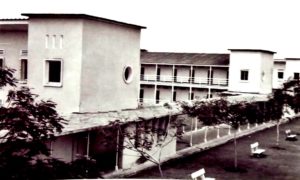The history of technical education in this country has been a century old. It all began in 1904 when a Technical School began its operation on Weld Road (now Jalan Raja Chulan) to teach Technical Assistants for the Federated Malay States, Departments of Railways, Survey and Public Works. The school was officially known as Treacher Technical School, named after Sir William Treacher, the Resident General during that time. Students followed classed on part-time basis, they worked and trained specifically according to the technical needs of their employment.
In 1941, the Advisor Committee of Technical Schools and the Education Department recommended that the Technical School be elevated to a college status and proposed that a new Technical College be constructed. The new college was to be built on a 47 acre piece of Government land in Gurney Road (now Jalan Sultan Yahya Petra), Kuala Lumpur. Plans for the construction of the college, however, were put on hold when World War II erupted in Peninsular Malaysia.
During the Japanese occupation of Malaya, the college was known as “ShihanGakko” then at its High Street (now Jalan Bandar) premises. It was headed by Mr. Arimoto and assisted by Mr.N.A.K. Nair who later became its Principal. After the liberation, the College was reopened on September 16, 1946 and the plan to build a completed new Technical College was resumed. The British Government allocated fund for capital costs of building and equipping the college. The Technical College was eventually completed and was officially opened on March 1, 1955 by Sir Donald MacGilivray, the then British High Commissioner to Malaya.
In the early years, the Technical College conducted engineering courses at diploma level in Civil Engineering, Mechanical Engineering, Electrical and Radio Engineering, Land Surveying, Building Architecture and Quality Surveying, while a special in Automobile Engineering was offered for the transportation enforcement officers. The total enrollment for 1958/1959 academic session was 320 students.
In 1960, the College began a new era upgrading its engineering courses to the degree level. Student following courses at the college had the opportunities to sit for professional examinations conducted by the Institution of Civil Engineers and Institution of Mechanical Engineers, United Kingdom and the Royal Institute of British Architects, as well as the Royal Of Chartered Surveyors. Students for these professional courses were drawn for in service government servants for the Federation of Malaya, Singapore, Borneo and Brunei. Minimum entry requirements then were Grade I and II in the Cambridge School Certificate or the Malayan School Certificate with credits in English Language and Basic Mathematics. Priorities were given to those who obtained credits in Science subjects.
By the 1965/1966 academic session, there were 682 full-time students studying at the Technical College. The increase in the enrolment was a direct result of the shift in the government’s policy which gave more emphasis on technology-oriented industries in order to develop the growing economy. Subsequent to this change, demands for trained human resources in the technical fields rose remarkably. With the rapid economic expansion, Technical College became the popular choice for further education, well supported by its many modern and improved teaching facilities. For the year 1969 admission, the college received an overwhelming 1,300 entry applications when it could only accept about 280 students. By that time, the total enrolment of full-time students at the Technical College numbered at 872 students.
A committee was formed by the Ministry of Education in early 1971 to study the feasibility of upgrading Technical College into a university. The committee recommended the formation of a technological University using Bahasa Melayu as the medium of instruction. On March 14, 1972, Malaysia’s Supreme Ruler, DYMM Seri Paduka Baginda Yang Dipertuan Agong officially proclaimed the formation of Institut Teknologi Kebangsaan (ITK) under section 6(1) of the University and University College Act 1971. This new institution inherited all the basic amenities and facilities of the former Technical College of Gurney Road.




